Apps
Auto Added by WPeMatico
Auto Added by WPeMatico
If you ask Nik Bonaddio why he wanted to build a new mobile trivia app, his answer is simple.
“In my life, I’ve got very few true passions: I love trivia and I love sports,” Bonaddio told me. “I’ve already started a sports company, so I’ve got to start a trivia company.”
He isn’t kidding about either part of the equation. Bonaddio actually won $100,000 on “Who Wants To Be A Millionaire?”, which he used to start the sports analytics company numberFire (acquired by FanDuel in 2014).
And today, after a period of beta testing, Bonaddio is launching BigBrain. He’s also announcing that the startup has raised $4.5 million in seed funding from FirstRound Capital, Box Group, Ludlow Ventures, Golden Ventures and others.
Of course, you can’t mention mobile trivia without thinking of HQ Trivia, the trivia app that shut down last year after some high-profile drama and a spectacular final episode.
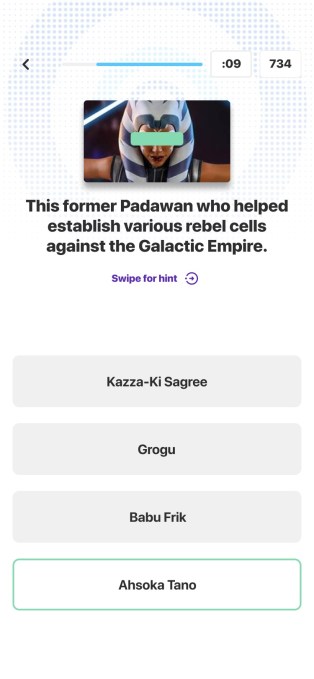
Image Credits: BigBrain
But Bonaddio said BigBrain is approaching things differently than HQ in a few key ways. For starters, although there will be a handful of free games, the majority will require users to pay to enter, with the cash rewards coming from the entry fees. (From a legal perspective, Bonaddio said this is distinct from gambling because trivia is recognized as a game of skill.)
“The free-to-play model doesn’t really work for trivia,” he argued.
In addition, there will be no live video with a live host — Bonaddio said this would be “very, very difficult from a technical perspective and very cost ineffective.” Instead, he claimed the company has found a middle ground: “We have photos, we have different interactive elements, it’s not just a straight multiple choice quiz. We do try to keep it interactive.”
Plus, the simpler production means that where HQ was only hosting two quizzes a day, BigBrain will be hosting 20, with quizzes every 15 minutes at peak times.
Topics will range from old-school hip hop to college football to ’90s movies, and Bonaddio said different quizzes will have different prize structures — some might be winner take all, while others might award prizes to the top 50% of participants. The average quiz will cost $2 to $3 to enter, but prices will range from free to “$20 or even $50.”
What kind of quiz might cost that much money to enter? As an example, Bonaddio said that in a survey of potential users, he found, “There are no casual ‘Rick and Morty’ fans … They’re almost completely price sensitive, and since they’ve seen every episode, they can’t fathom a world where someone knows more about ‘Rick and Morty’ than they do.”
Powered by WPeMatico
TikTok is expanding its integrations with third-party apps. The company today announced the launch of two new tool sets for app developers, the TikTok Login Kit and Sound Kit, that will allow apps on mobile, web and consoles to authenticate users via their TikTok credentials, build experiences that leverage users’ TikTok videos and share music and sounds back to TikTok from their own apps.
The company already offers tools that allow app developers to share content, including both pictures and videos, back to TikTok. But the new kits — or, SDKs (software development kits) — expand upon that functionality to make TikTok not just a destination for sharing, but a more deeply integrated part of the third-party app experience.
For starters, the new Login Kit allows an app’s users to sign in quickly using their TikTok log-in credentials, similar to other social log-ins offered by Facebook or Snap. Once signed in, users can then access their TikTok videos in the third-party app, potentially fueling entire new app ecosystems with TikTok content.
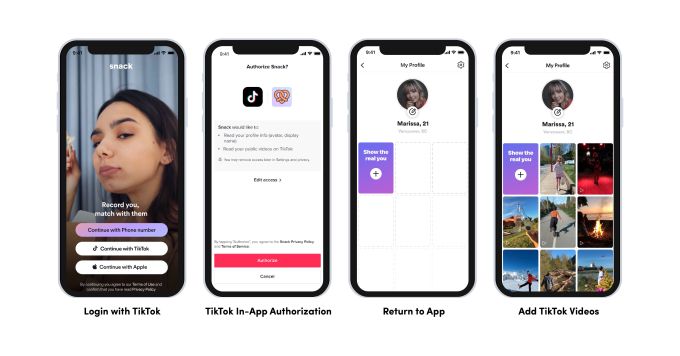
Image Credits: TikTok
For example, a video dating app called Snack is using the Login Kit to allow users to share their TikTok videos on their dating profiles to help them find new matches. The game recording app Medal will allow users to share their TikTok videos with their fellow gamers. And Singapore-based Burpple lets users share their food and dining reviews with a community.
Other early adopters of the Login Kit include gaming clips app Allstar, anti-anxiety app Breathwrk, social app IRL, as well as dating and friend-making apps Lolly, MeetMe, Monet, Swipehouse and EME Hive. Creator tool provider Streamlabs is also using Login Kit, as is video game PUBG, which is only using the login functionality. A forthcoming NFT platform Neon will use Login Kit, too.
When users log in to these apps via their TikTok credentials, they’ll then be presented with an additional permissions box that asks them if the app in question can read their profile information and access their public videos, which they then have to also agree to in order to take advantage of the additional video sharing options inside the app itself.
For the time being, these are the only permissions that Login Kit asks for — and it doesn’t give the app access to further information, like who the TikTok user’s friends are, for example. If TikTok expands beyond these permissions in the future, it says it will be transparent with users about any changes or new additions. For the time being, however, the focus is more on allowing apps to better integrate TikTok content into their own experiences.
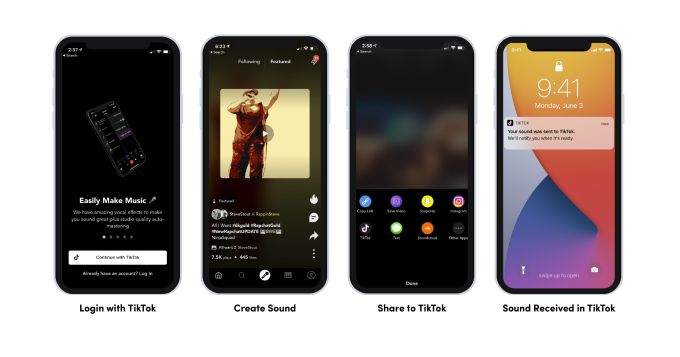
Image Credits: TikTok/Rapchat
The other new SDK launching today is the Sound Kit, which allows artists and creators to bring their original sounds and music from a third-party app into TikTok. This kit, which also requires Login Kit to work, will help TikTok seed its sounds database with more original content it doesn’t have to license from major labels. Instead, whatever licensing rights to the music and other sounds that exist within the original app will still apply to whatever is shared out to TikTok. But by sharing the music more broadly, creators can gain interest from potential fans and even see their sounds used as the backing for new TikTok videos.
Early adopters on this front include mobile multi-track recording studio Audiobridge, music creation and collaboration suite LANDR, hip hop music creation app Rapchat and upcoming audio recording and remix app Yourdio.
TikTok says some of the apps selected as early partners for the SDKs were those that already adopted its Share to TikTok SDK, which launched in 2019. Others, however, were chosen based on a specific set of criteria, including the ability to move quickly to integrate the new features and the strength of their specific use cases. TikTok was looking for a diversity of use cases and those that were particularly novel — like building out a dating network based on videos, for instance.
More information on the new tools and developer documentation will be added to TikTok’s developer website, but TikTok says it will be vetting and reviewing developers who request access. And as most of the current developer partners are U.S.-based, with just a few exceptions, the company says it is looking to diversify the list of companies going forward, as this is a global initiative.
“As TikTok becomes increasingly ingrained in culture, more third-party apps across a variety of categories and use cases are looking to tap into our community on their own platforms,” said Isaac Bess, TikTok’s Global Head of Distribution Partnerships, in a statement about the launch. “Through the Sound Kit and Login Kit for TikTok, we’re providing seamless integration solutions that help developers expand their reach, increase exposure for creators, and empower our community to showcase their content on other platforms,” he added.
Powered by WPeMatico
Snap on Wednesday announced its plan to soon launch a Creator Marketplace, which will make it easier for businesses to find and partner with Snapchat creators, including Lens creators, AR creators and later, prominent Snapchat creators known as Snap Stars. At launch, the marketplace will focus on connecting brands and AR creators for AR ads. It will then expand to support all Snap Creators by 2022.
The company had previously helped connect its creator community with advertisers through its Snapchat Storytellers program, which first launched into pilot testing in 2018 — already a late arrival to the space. However, that program’s focus was similar to Facebook’s Brand Collabs Manager, as it focused on helping businesses find Snap creators who could produce video content.
Snap’s new marketplace, meanwhile, has a broader focus in terms of connecting all sorts of creators with the Snap advertising ecosystem. This includes Lens Creators, Developers and Partners, and then later, Snap’s popular creators with public profiles.
Snap says the Creator Marketplace will open to businesses later this month to help them partner with a select group of AR Creators in Snap’s Lens Network. These creators can help businesses build AR experiences without the need for extensive creative resources, which makes access to Snap’s AR ads more accessible to businesses, including smaller businesses without in-house developer talent.
Lens creators have already found opportunity working for businesses that want to grow their Snapchat presence — even allowing some creators to quit their day jobs and just build Lenses for a living. Snap has been further investing in this area of its business, having announced in December a $3.5 million fund directed toward AR Lens creation. The company said at the time there were tens of thousands of Lens creators who had collectively made over 1.5 million Lenses to date.
Using Lenses has grown more popular, too, the company had noted, saying that more than 180 million people interact with a Snapchat Lens every day — up from 70 million daily active users of Lenses when the Lens Explorer section first launched in the app in 2018.
Now, Snap says that over 200 million Snapchat users interact with augmented reality on a daily basis, on average, out of its 280 million daily users. The majority (over 90%) of its U.S. users are 13 to 25-year-olds. In total, users are posting over 5 billion Snaps per day.
Snap says the Creator Marketplace will remain focused on connecting businesses with AR Lens Creators throughout 2021.
The following year, it will expand to include the community of professional creators and storytellers who understand the current trends and interests of the Snap user base and can help businesses with their ad campaigns. The company will not take a cut of the deals facilitated through the Marketplace, it says.
This would include the creators making content for Snap’s new TikTok rival, Spotlight, which launched in November 2020. Snap encouraged adoption of the feature by shelling out $1 million per day to creators of top videos. In March 2021, over 125 million Snapchat users watched Spotlight, it says.
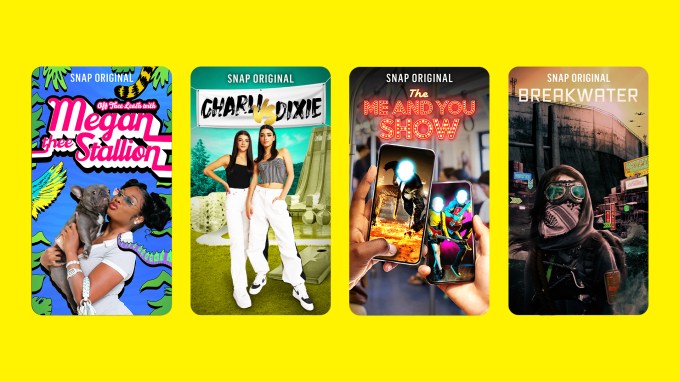
Image Credits: Snapchat
Spotlight isn’t the only way Snap is challenging TikTok.
The company also on Wednesday announced it’s snagging two of TikTok’s biggest stars for its upcoming Snap Originals lineup: Charli and Dixie D’Amelio. The siblings, who have gained over 20 million follows on Snapchat this past year, will star in the series “Charli vs. Dixie.” Other new Originals will feature names like artist Megan Thee Stallion, actor Ryan Reynolds, twins and influencers Niki and Gabi DeMartino, and YouTube beauty vlogger Manny Mua, among others.
Snap’s shows were watched by over 400 million people in 2020, including 93% of the Gen Z population in the U.S., it noted.
“We’re happy to announce Snap’s Creator Marketplace, which will drive win-win-win opportunities for marketers, Creators, and Snap,” said Peter Naylor, Snap’s VP of Sales in the Americas, of the marketplace news. “For brands, it’s an opportunity to leverage the expertise of our network of AR Creators; for Creators, it gives them a way to further build a sustainable audience and business on the platform; and for Snap, it means more advertising partners can produce and execute compelling creative on Snapchat without the need for extensive resources,” he added.
Powered by WPeMatico
Instagram is making its video Stories and Reels more accessible with the launch of a new “captions sticker” that will allow users to watch without having the sound on. The addition will not only make it easier for users who are hard of hearing or deaf to engage with video content, it also offers a way for users to watch videos when they’re somewhere they don’t want to have their sound on — and either don’t want to wear or don’t have access to headphones or earbuds.
To use the feature, creators will first record a new video using the Stories or Reels Camera in the Instagram app, or select a video to upload from their phone’s gallery. Then, you’ll open the sticker tray and look for the new “Captions” sticker, which will convert your speech to text. You also can edit the style, position of the caption and the text and color so it matches your content. When you post, the captions will appear alongside your video for everyone to see.
At launch, the feature is only available in English and in English-speaking countries, but Instagram plans to roll it out to other countries and languages soon, it says. It’s also rolling out the captions sticker first to Stories and will then begin testing it in Reels, with a broader launch to follow.
The captions sticker had been spotted last year while in development, alongside other potential new additions, like a Collab sticker, Link sticker, Reshare sticker and others. Instagram parent Facebook also appears to have a captions sticker of its own in development. The sticker then began testing earlier this spring with some number of Instagram users.
The addition comes only weeks after TikTok announced its own captions feature, which it calls auto captions. The two products are somewhat different, however. Auto captions automatically translate the speech from a TikTok video in either American English and Japanese, to start, but the text itself isn’t customizable and can be turned on or off by the viewer from the app’s share panel. It also hasn’t yet been broadly adopted and many TikTok creators tend to still use captions they create themselves or via third-party apps.
Instagram notes it had previously launched support for captions across Threads and IGTV, but its expansion to Stories and Reels will make more of an impact, given that Instagram Stories alone is used by more than 500 million people every day.
Powered by WPeMatico
Twitter this morning announced it’s acquiring Scroll, a subscription service that offers readers a better way to read through long-form content on the web, by removing ads and other website clutter that can slow down the experience. The service will become a part of Twitter’s larger plans to invest in subscriptions, the company says, and will later be offered as one of the premium features Twitter will provide to subscribers.
Premium subscribers will be able to use Scroll to easily read their articles from news outlets and from Twitter’s own newsletters product, Revue, another recent acquisition that’s already been integrated into Twitter’s service. When subscribers use Scroll through Twitter, a portion of their subscription revenue will go to support the publishers and the writers creating the content, explains Twitter in an announcement.
Scroll’s service today works across hundreds of sites, including The Atlantic, The Verge, USA Today, The Sacramento Bee, The Philadelphia Inquirer and The Daily Beast, among others. For readers, the experience of using Scroll is similar to that of a “reader view” — ads, trackers and other website junk is stripped so readers can focus on the content.
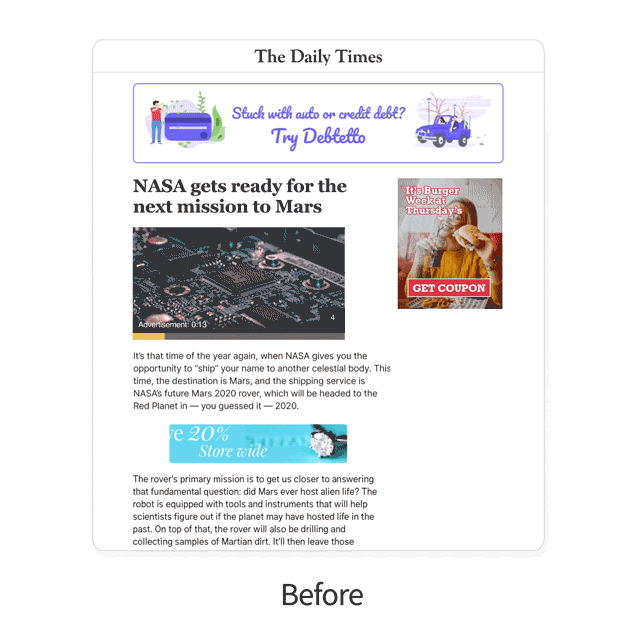
Image Credits: Twitter
Scroll’s pitch to publishers has been that it can end up delivering cleaner content that can make them more money than advertising alone.
Deal terms were not disclosed, but Twitter will be bringing on the entire Scroll team, totaling 13 people.
For the time being, Scroll will pause new customer sign-ups so it can focus on integrating its product into Twitter’s subscriptions work and prepare for the expected growth. It will, however, continue to onboard new publishers who want to participate in Scroll’s network, following the deal’s closure.
And Scroll itself will be headed back into private beta as the team works to integrate the product into Twitter.
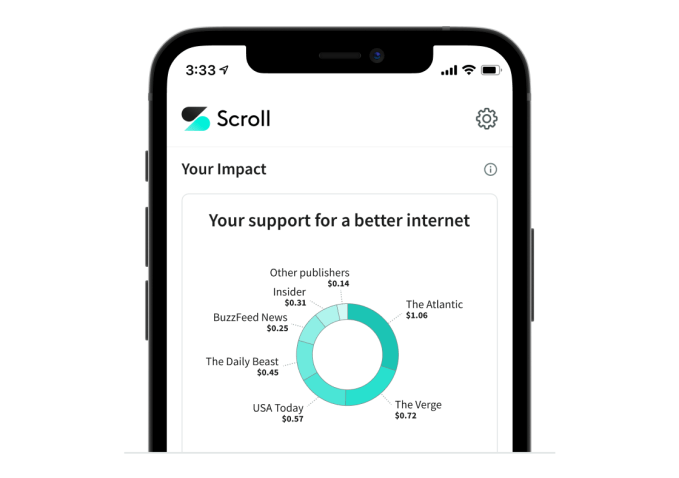
Image Credits: Twitter
Twitter says it will also be winding down Scroll’s news aggregator product, Nuzzel, but will work to bring some of Nuzzel’s core elements to Twitter over time. Nuzzel’s blog post has more details, explaining that the product will need to be rebuilt in order to scale with Twitter.
“Twitter exists to serve the public conversation. Journalism is the mitochondria of that conversation. It initiates, energizes and informs. It converts and confounds perspectives. At its best it helps us stand in one another’s shoes and understand each other’s common humanity,” said Tony Haile, Scroll CEO, in the company’s post about Scroll’s acquisition.
“The mission we’ve been given by Jack and the Twitter team is simple: take the model and platform that Scroll has built and scale it so that everyone who uses Twitter has the opportunity to experience an internet without friction and frustration, a great gathering of people who love the news and pay to sustainably support it,” he added.
Twitter earlier this year detailed its plans to head into subscriptions as a way to diversify beyond ad revenue for its own business. The company unveiled what it’s calling “Super Follow,” a creator-focused subscription that would give paid subscribers access to an expanded array of perks, like exclusive content, subscriber-only newsletters, deals, badges, paywalled media and more. The company is aiming to use this new product to help it achieve its goal of doubling company revenue from $3.7 billion in 2020 to $7.5 billion or more in 2023, it said.
Powered by WPeMatico
An Indian startup that began its life after the global pandemic broke last year said on Tuesday it has concluded its third financing round as it enables hundreds of thousands of teachers in the world’s second-largest internet market to run classes online and serve their students.
Bangalore-based Teachmint said today it has raised $16.5 million in its Series A financing round. The round was led by Learn Capital, the San Francisco Bay Area-headquartered venture capital firm that focuses on edtech firms and has backed some of the world’s most promising online learning startups, including Coursera, Udemy, Nerdy, Minerva and Brainly.
CM Ventures, and existing investors Better Capital, which first invested in Teachmint before the startup had even registered itself, and Lightspeed India Partners also participated in the new round, which brings the Indian startup’s to-date raise to $20 million.
Teachmint helps teachers conduct classes online through an app on their Android smartphone, iPhone or the web. The startup has built an all-in-one product that allows teachers to kickstart a live class, do doubt-clearing sessions, take attendance, conduct webinars, collect fees, find new students, offer support via phone calls and take tests, among other tasks.
“When the pandemic broke, teachers were struggling with several tools including Google Meet, Zoom and even YouTube/Facebook Live to teach online. They were using additional tools like Google Forms for tests and WhatsApp for communication. It was a difficult and disconnected experience for most teachers as none of these tools were productised for teaching. That’s when we decided to build a mobile-first video-first solution specifically for teaching,” said Mihir Gupta, co-founder and chief executive of Teachmint, in an interview with TechCrunch.
The product, available in 10 local languages, is highly localised for India-specific needs, said Gupta.
More than 700,000 teachers from over 1,500 cities and towns have signed up on the platform in less than 10 months since the launch of Teachmint’s product, said Gupta.
“From the Learn Capital team’s first meeting with Teachmint’s co-founders several months ago, it was clear that their collective team had meticulously architected an end-to-end, multi-modal, and best-in-class solution enabling teachers in India to instantly and seamlessly digitize their classrooms,” said Vinit Sukhija, partner at Learn Capital, in a statement.
“Now with over 700,000 teachers, Teachmint has become India’s leading online teaching platform,” he said, adding that Learn Capital believes that Teachmint can eventually expand its offering outside of India.
Gupta said Teachmint is currently not monetizing its product, and doesn’t intend to do so in the immediate future as it is currently prioritizing reaching more teachers in India and also expand its offerings.
He said most teachers have learnt about Teachmint through friends as it has limited investment in marketing. Teachmint is open to exploring any strategic acquisition opportunities with smaller startups, he said.
Powered by WPeMatico
It looks like everyone and their mother is trying to reinvent the Brazilian banking system. Earlier this year we wrote about Nubank’s $400 million Series G, last month there was the PicPay IPO filing and today, alt.bank, a Brazilian neobank, announced a $5.5 million Series A led by Union Square Ventures (USV).
It’s no secret that the Brazilian banking system has been poised for disruption, considering the sector’s little attention to customer service and exorbitant fee structure that’s left most Brazilians unbanked, and alt.bank is just the latest company trying to take home a piece of the pie.
Following Nubank’s strategy of launching a bank with colors that are very un-bank-like, signaling that they do things differently, alt.bank similarly launched its first financial product in 2019 — a fluorescent-yellow debit card which the locals have endearingly dubbed, “o amarelinho,” meaning, “the little yellow card.”
The company, founded by serial entrepreneur Brad Liebmann, follows the founder’s $480 million exit of Simply Business, which was acquired by U.S. insurance giant Travelers in 2017.
Unlike many fintechs, alt.bank has a strong social mission and pays commissions for referrals that last for the customer’s lifetime.
“Most fintechs just help wealthy people get wealthier, so I thought let’s do something with a social mission,” Liebmann told TechCrunch in an interview.
To drive home the mission, and really target the unbanked, Liebman and his team of 80 employees have designed an app that can be used by the illiterate. Instead of words, users can follow color-coded prompts to complete a transaction. The company also plans to launch credit products soon.
According to the company, close to a million people have downloaded the android app since launch, but Liebman declined to disclose how many active users the company actually has.
Today, the company’s core offerings include the debit card, a prepaid credit card, Pix (similar to Zelle), a savings account and even telemedicine visits via a partnership with Dr. Consulta, a network of healthcare clinics throughout the country. The prepaid credit card is key because online stores in Brazil don’t accept debit card purchases.
In addition to the perk of ongoing commissions, alt.bank has also partnered with three major drugstores, allowing their users to get 5-30% off any item at the stores, including medication.
While the company is based in São Paulo and São Carlos, Liebmann and his family are currently based in London due to regulations around the pandemic.
The investment in alt.bank marks USV’s first investment in South America, solidifying a trend by other major U.S. investors such as Sequoia who only in the last several years have started looking to LatAm for deals.
“The bar was high for our first investment in South America,” said Union Square Ventures partner John Buttrick. “The combination of the alt.bank business model and world-class management team enticed us to expand our geographic focus to help build the leading digital bank targeting the 100 million Brazilians who are currently being neglected by traditional lenders,” he added in a statement.
Powered by WPeMatico
Sony and Discord have announced a partnership that will integrate the latter’s popular gaming-focused chat app with PlayStation’s own built-in social tools. It’s a big move and a fairly surprising one given how recently acquisition talks were in the air — Sony appears to have offered a better deal than Microsoft, taking an undisclosed minority stake in the company ahead of a rumored IPO.
The exact nature of the partnership is not expressed in the brief announcement post. The closest we come to hearing what will actually happen is that the two companies plan to “bring the Discord and PlayStation experiences closer together on console and mobile starting early next year,” which at least is easy enough to imagine.
Discord has partnered with console platforms before, though its deal with Microsoft was not a particularly deep integration. This is almost certainly more than a “friends can see what you’re playing on PS5” and more of a “this is an alternative chat infrastructure for anyone on a Sony system.” Chances are it’ll be a deep, system-wide but clearly Discord-branded option — such as “Start a voice chat with Discord” option when you invite a friend to your game or join theirs.
The timeline of early 2022 also suggests that this is a major product change, probably coinciding with a big platform update on Sony’s long-term PS5 roadmap.
While the new PlayStation is better than the old one when it comes to voice chat, the old one wasn’t great to begin with, and Discord is not just easier to use but something millions of gamers already do use daily. And these days, if a game isn’t an exclusive, being robustly cross-platform is the next best option — so PS5 players being able to seamlessly join and chat with PC players will reduce a pain point there.
Of course Microsoft has its own advantages, running both the Xbox and Windows ecosystems, but it has repeatedly fumbled this opportunity and the acquisition of Discord might have been the missing piece that tied it all together. That bird has flown, of course, and while Microsoft’s acquisition talks reportedly valued Discord at some $10 billion, it seems the growing chat app decided it would rather fly free with an IPO and attempt to become the dominant voice platform everywhere rather than become a prized pet.
Sony has done its part, financially speaking, by taking part in Discord’s recent $100 million H round. The amount they contributed is unknown, but perforce it can’t be more than a small minority stake, given how much the company has taken on and its total valuation.
Powered by WPeMatico
R.I.P. Madefire, a startup that recruited high-profile artists to reinvent comics for new formats and platforms.
An announcement on the Madefire website states the company entered into “an assignment of benefit for creditors” (explained as “a state-level insolvency proceeding similar to bankruptcy”) earlier this month, which was then reported this morning in The Beat. As a result, no new books will be published, users will not be able to purchase any additional books and they’re also encouraged to download all their purchased content before the end of the month.
This news affects other apps built with Madefire’s technology. The Archie comics app has shut down as well, with the publisher writing, “We realize this comes as a surprise and we are making every effort to do right by our loyal customer base,” specifically by offering readers a free one-month subscription to Comixology Unlimited. (Amazon acquired digital comics platform Comixology in 2014, launching an Unlimited subscription service two years later.)
Madefire first launched in 2012, back when publishers were experimenting with formats like motion comics. The company described its titles as “motion books,” combining the animation and effects of motion comics with a more traditional reading experience.
“Motion comics are a passive experience, a watching experience that is tantamount to bad animation – it’s like watching a movie,” co-founder and CEO Ben Wolstenholme said at the time. “Motion Books is a reading experience, actively controlled by the reader – it’s like reading a book. Our goal is to be the best reading experience developed for the iPad.”
Perhaps the most impressive thing about the company was the artists it had enlisted before launch, including Dave Gibbons and Bill Sienkiewicz.
More recently, Madefire announced partnerships with other tech platforms, including Snapchat and troubled augmented reality company Magic Leap.
According to Crunchbase, Madefire had raised $16.4 million in funding from investors including True Ventures, Plus Capital, Kevin Spacey (yes, that Kevin Spacey) and Drake, but The Beat reports that the total was “even more than that.”
Powered by WPeMatico
PreShow Interactive is giving gamers a new way to earn in-game currency in exchange for watching ads — a concept that’s become familiar in mobile games but hasn’t really made much headway on PCs or consoles.
The startup is led by MoviePass’ founding CEO Stacy Spikes. When I spoke to Spikes about PreShow two years ago, he was beta testing an app that provided users with free movie tickets in exchange for watching ads. But obviously, theatrical moviegoing has taken a big hit in the past year.
Spikes told me yesterday that he’d always hoped to bring the PreShow concept to four categories — theatrical movies, gaming, subscription streaming and video on demand — but the pandemic forced the startup to shift focus more quickly than expected and explore what a gaming experience might look like.
The current plan is to launch a new PreShow Interactive app this summer, where viewers can connect their in-game accounts and identify how much virtual currency they want to earn. Then they watch a package of ads and PreShow will automatically transfer the currency to their account — in other words, it’s buying the currency for them.
Users will have to download a separate app to watch the ads and get the benefits, but Spikes said this is actually better than trying to integrate advertising or branded content into the game itself, which can be a slow process for the developer and the advertiser, while also being distracting for the players. And this means PreShow Interactive should be able to support 20,000 games at launch, across PCs, consoles and virtual reality.
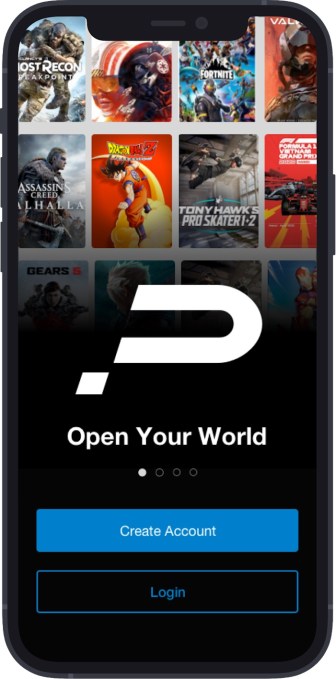
Image Credits: PreShow Interactive
“We just didn’t see the purpose of spending the time on integrations when it’s not really necessary,” he added. “Our deal is only with the consumer for their time. We’re saying, ‘This is your time. It has value.’ ”
One of the key elements to Preshow’s approach is technology that can detect when the viewer is actually looking at their phone screen — the ads will stop playing if you turn away. This has been criticized as “creepy surveillance tech,” but Spikes claimed that early PreShow users have embraced it. He also argued that it’s more transparent than the data collection and targeting currently driving online advertising.
“We used to think data was the new oil, but now our feeling is that permission and engagement and attention is the new oil,” he said.
In addition to revealing its new strategy, PreShow is announcing that it has raised $3 million in seed funding led by Harlem Capital, with participation by Canaan Partners, Wavemaker Partners, Front Row Fund, ROC Fund, BK Fulton and Monroe Harris.
And to be clear, Spikes said PreShow isn’t abandoning theatrical movies. He said that the PreShow app will eventually offer both movie and gaming deals “under one roof,” but brands aren’t currently eager to advertise to moviegoers.
“We’re ready to go when the marketplace is ready to go,” he said.
Powered by WPeMatico